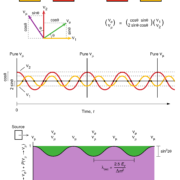Quantum decoherence with ORCA6
30 October 2024 – Search for quantum decoherence in neutrino oscillations with six detection units of KM3NeT/ORCA
(KM3NeT paper, submitted to JCAP, arXiv: 2410.01388)
In a new paper we search for quantum decoherence in neutrino oscillations by looking for deviations of the standard neutrino oscillation pattern. We report upper limits on the decoherence parameters using data from ORCA6.
Usually, neutrino oscillations are studied in the framework of quantum mechanics assuming that the neutrino system is isolated. In this paper we study neutrino oscillations in the framework of open quantum systems, where the neutrino is coupled to a larger environment.
Several theories of quantum gravity postulate fluctuations in spacetime as a stochastic environment. A neutrino that propagates in such an environment will experience changes to its quantum phase. This will lead to a loss of coherence of the neutrino mass eigenstates during propagation. The phenomenon is referred to as decoherence in neutrino oscillations.
The search for decoherence in neutrino oscillations provides a rare opportunity to investigate quantum gravitational effects which are usually beyond the reach of current experiments.
The ORCA detector of KM3NeT is particularly designed to detect neutrinos generated in collision of cosmic ray particles with the Earth’s atmosphere. The atmospheric neutrinos are good probes to study oscillations and hence to search for quantum decoherence effects.
We used the neutrino data collected by the ORCA6 detector – an early detector configuration with six detection units – in the period January 2020 to November 2021. In the analysis we focused on atmospheric neutrinos with energies of a few GeV to 100 GeV. We measured the parameters Γ21 and Γ31, that describe decoherence, assuming a power-law dependency on the neutrino energy Γij ∝ (E/E0)n and explored two cases: with n = -2 and with n = -1.
Results
No significant deviation with respect to the standard oscillation hypothesis is observed. Therefore, 90% CL upper limits for the two cases are estimated as
The decoherence sensitivity of ORCA depends on the neutrino mass ordering. Therefore, we report upper limits for both normal and inverted ordering.
The results are comparable to bounds reported for IceCube/DeepCore and display the same dependency on the mass ordering.
In the figure below the 90% confidence level contours for Γ21 and Γ31 are shown for a decoherence model fitting both normal (NO) and inverted (IO) neutrino mass orderings.





